| |
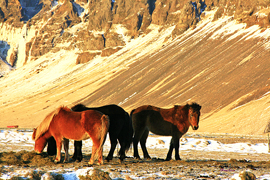 |
|
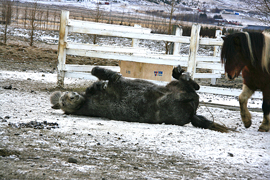 |
|
| |
Icelandic horses |
|
A good roll after a ride |
|
| |
|
|
| |
It was still dark, with the light pink of dawn beginning to touch the cliff tops. Swaddled in my down snowmobile suit, heavy mittens, goggles, earmuffs, scarves and boots, I could hardly hold the reins of my shaggy horse as we trotted down the gravel road. I was not alone in losing control of the situation. But this was Iceland, and things are different here.
| |
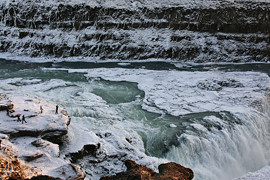 |
|
| |
The power of nature in Iceland |
|
Winter sunrise in the Polar Arctic comes slowly, the light merely diluting the dark sky with tinges of pale egg-blue and pink. It was 10:30 when the sky began to lighten. By noon it would be full blown daylight with the sun hovering close to the horizon for a few hours before fading again into darkness. I was in Iceland to celebrate New Years and this was the morning of New Year’s Eve. Twenty of us were bundled up beyond recognition, riding Iceland’s equivalent of the shaggy Thelwell pony, their distinctive and genetically pure Icelandic horse.
|
|
| |
|
|
| |
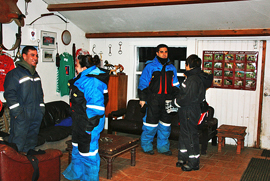 |
|
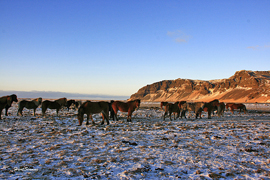 |
|
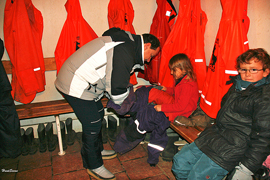 |
|
| |
Suiting up for an Icelandic horse ride |
|
Harsh conditions in the volcanic pasture |
|
Getting kids into snowsuits to ride |
|
| |
|
|
|
|
|
|
| |
Laxnes Horse Farm (former home of Halldor Laxness, a 1955 winner of the Nobel Prize for Literature) provides snowmobile suits, woolen scarves and helmets for riders. In addition, I had on two pairs of long underwear, lined cross country ski pants, a heavy sweater, ski gloves, woolen socks and hiking boots. After help getting dressed, we waddled outside to be matched up with our horses. I was assigned a wonderful, willful little lava-colored mare with an unpronounceable Icelandic name. She insisted on being up front of the group. |
|
| |
|
|
|
|
| |
 |
|
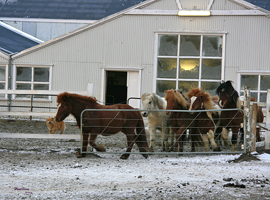 |
|
| |
Laxnes Horse Farm pasture |
|
Laxnes horses heading to pasture |
|
| |
|
|
| |
As tough as the Viking Icelanders are, the Icelandic horses are tougher. Surviving centuries of the harshest possible wet and blustery winters, isolation and being used as beasts of burden have molded the horses that survived into a compact and squarely-built horse. There is only one breed in the country and that has had no infusion of outside blood for over 800 years. To conserve heat, Icelandics have short legs, a short neck with little short ears set high, good digestion and a winter coat that is long and thick, making it resistant to extraordinary conditions.
Their incredibly thick winter coats and shaggy manes look impossible to comb but that’s what makes them the cutest little horses on the planet. That thick mane not only keeps the horses warm, it helps us humans, too. Even with my layers of clothing, my fingers and toes got cold. By putting my hands under the mare’s thick mane they quickly warmed up; my toes were on their own. |
|
| |
|
|
| |
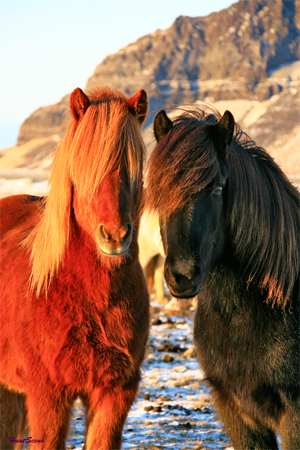 |
|
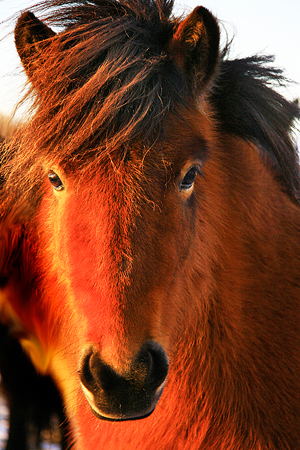 |
|
| |
Best friends |
|
Icelandic head |
|
| |
|
|
| |
In addition to walk, trot, canter, Icelandic horses have the distinctive tolt and pace. The tolt is a smooth four-beat gait, in which the horse moves its feet in the same order as the walk, the difference being the phases of the gait—how many and which of the horse’s feet are on the ground at a given time. A tolting horse carries his head and neck proudly elevated and a visible wave of energy flows through his tail. Even though it seems that the horse’s legs are moving wildly, the rider is sitting smoothly.
The pace is a two-beat gait with legs moving laterally in pairs at great speed. In the time between the left and right pair support, there is a phase of suspension in which all four feet are in the air and the horse is in flight. Racing pacers can reach speeds of 30 mph. |
|
| |
|
|
| |
 |
|
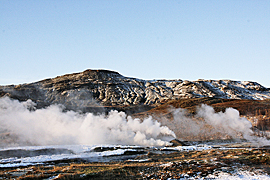 |
|
| |
Typical Iceland farm |
|
Haukadalur geothermal landscape |
|
| |
|
|
|
|
| |
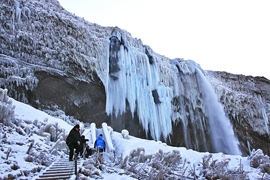 |
Our group continued up and down hills, across pastures, raced along fences, forded icy creeks and pounded the gravel roads. People may have thought we were crazy to be riding, but we passed even crazier foursomes of golfers whacking balls in the dim light on the brown golf course. There is something in the Viking heritage that makes them do wild and crazy things. You’d better be as tough as these Vikings, or at least pretend to be, if you want to keep up. |
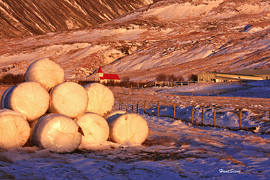 |
|
| |
Seljalands frozen waterfall |
|
Hay bales wrapped in plastic |
|
| |
|
|
|
|
| |
Our guide never bothered to look back, merely forged ahead with horses behind her doing a variety of gaits, from a trot to tolt to pace or gallop. Fortunately, nothing seemed to excite the horses, other than keeping up with their buddies. One rider couldn’t handle it, however, and was escorted back to the stables. One young French boy had dismounted to see to Nature’s call and as we took off so did his horse. He came running up in tears when his parents finally realized he was no longer with the group. His little sister was so tiny I’m not sure her horse even knew she was there and, of course, did what he wanted. In fact, most of the shaggy beasts did what they wanted, with little control from the pathetic humans on top of them. |
|
| |
|
|
| |
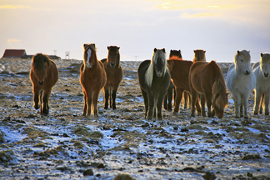 |
|
The last stretch of road back to the barn was a speed contest. I had no idea my little 14-hand mare could gallop so fast and I prayed she wouldn’t skid on the gravel as she banked the turns. It was an Oh S*** experience, but we all had big grins on our red-cheeked faces when we dismounted. |
|
| |
Herd checking out person in their territory |
|
|
|
| |
|
|
|
|
| |
Why Iceland in Winter?
Winter in the Arctic is fascinating, the very unfamiliarity of such an extreme climate is its allure. Twinkling lights punctuating the constant darkness is inviting, the crisp cold invigorating, especially when the snow squeaks under your feet, no movie can compare to the amazing Aurora Borealis when it sweeps the clear sky with psychedelic colors and, probably most appealing, it is a time of few tourists—a time when I feel the natives are being themselves rather than wearing their tourist masks. The cultural season in Iceland generally runs from fall through spring, offering concerts from symphonic to operatic to rock. |
|
| |
|
|
| |
Other reasons to visit Iceland in winter
Reykjavik, Europe’s northernmost capital, is a clean, safe and charming city, with quality restaurants and shopping. The hundreds of New Year’s Eve fireworks and bonfires during the New Year Festival make this the biggest party of the year, definitely among the most spectacular New Year’s celebrations in the world. Everyone speaks English, so it is easy to set up your own itinerary or you can take part in tours that are organized around the New Year’s Eve festivities. |
|
| |
|
|
|
|
|
|
| |
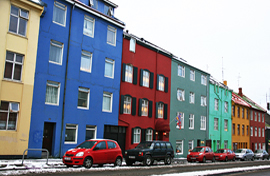 |
|
 |
|
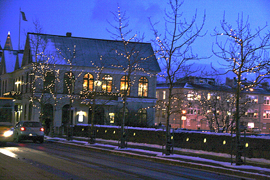 |
|
| |
Reykajavik's bright colors |
|
Sunday on Tjornin Lake in Reykajavik |
|
Iceland winter afternoon |
|
| |
|
|
| |
Must-sees in and around Reykjavik include soaking in the steaming waters of the Blue Lagoon, visiting the National Museum of Iceland, admiring the art collection in the Hotel Holt over a glass of fine wine, seeing the Medieval Manuscripts in the Arni Magnusson Institute. Watching the ice skaters on Tjornin Lake, downtown Reykjavik, is like observing a living Norman Rockwell painting.
Fifteen minutes outside of Reykjavik is the Great Outdoors. The volcanoes and waterfalls are incredibly beautiful in the low, winter light while the geo-thermal greenhouses show the possibilities of life without fossil fuels. While it is not possible to live totally oil-free, Iceland gets 75 percent of its energy needs from hydro and geothermal sources. |
|
| |
|
|
| |
 |
|
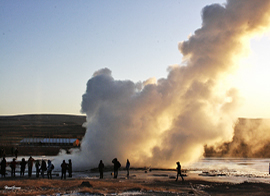 |
|
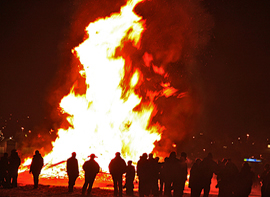 |
|
| |
Reykajavik New Year's Eve fireworks |
|
Strokkur Geyser eruption |
|
New Year's Eve bonfire |
|
| |
|
|
|
|
|
|
| |
Hiking is a national pastime, there is river rafting, skiing summer and winter, fishing, whale watching, bird watching, especially the Westman Islands, and Four-Wheeling. If you choose to drive yourself, check and re-check the mountain passes to the interior—some don’t open until early July. Farmhouse stays are an excellent way to get to know the Icelandic people and to be close to activities.
An Atlas shows an island the size of Ohio floating all by itself in the North Atlantic, looking a bit lonely. Iceland lies just below the Polar, or Arctic Circle, atop the Mid-Atlantic Ridge. This makes the island an exciting place, prone to floods, earthquakes, volcanic eruptions, lightning, storm surges and avalanches. The phone book (one for the entire country) gives instruction on what to do in each circumstance in Icelandic and English. |
|
| |
|
|
| |

|
|
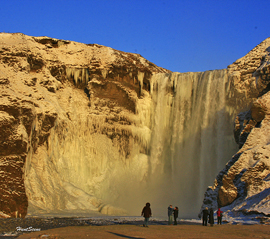 |
|
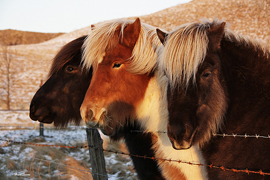
|
|
| |
Best friends |
|
Iceland waterfalls |
|
A troika of Icelandics |
|
| |
|
|
|
|
|
|
| |
A bit of phone book trivia—people are listed by their first names. This is because of the complicated system of using patronyms rather than surnames. So someone called Magnus Petursson is Magnus, the son of Petur. If Magnus has a daughter, she might be called Margret Magnusdottir, or Margret, the daughter of Magnus. Women do not change their names when they get married and so a husband, wife, son and daughter of the same family can all have different last names. That’s why people almost always use only first names in Iceland—even the President.
It is about a five hour non-stop flight from Boston or New York to Keflavik International Airport serving Reykjavik. Icelandair will begin summer service from Washington Dulles International Airport with four flights a week starting May 17, 2011 through September 13, 2011 for only $429 round trip.
Maybe I should go back on June 21st, just to experience the longest day.
#### For more information, go to www.visiticeland.com or www.icelandtouristboard.com. Riding information can be found at www.laxnes.is or www.hotellaxnes.is. |
|
| |
|
|
|

